To Save Giraffes, We May Need to Put Our Necks Out
With populations plummeting, researchers race to understand a beloved but enigmatic animal
/https://tf-cmsv2-smithsonianmag-media.s3.amazonaws.com/filer/fc/bb/fcbb1570-b676-44b4-98ec-bac7cb1e0662/mar2017_a06_giraffes.jpg)
Driving out of a forest of tall acacias one magical August day in Rwanda’s Akagera National Park, we came to a savanna of golden grass. There was a giraffe peering at us from behind a tree, not 200 feet away. He heard my two little nieces in the safari truck behind us screaming excitedly at the sight of him and, taking us in, decided we were not a threat. Somehow, he seemed to send a signal to eight other giraffes who were waiting hundreds of yards away, and they all started to approach, their long necks and legs swaying this way and that in a kind of slow-motion ballet.
The first giraffe, the scout, his ears twitching, came within 50 feet of us and licked his lips. Our son’s then-19-year-old girlfriend, Jen, blew him a juicy kiss from the back window. The giraffe reacted with a variety of quizzical facial expressions. The two seemed completely entranced with each other. The other eight giraffes surrounded us in a semicircle. All of them were looking hard at us, with no fear in their eyes. It was as if Adam’s wall, as the barrier between humans and other animals has been called, didn’t exist. But then my nieces jumped out of their truck squealing, and the giraffes receded as slowly and gracefully as they had come. The interspecies breakthrough moment ended just as it was beginning to happen.
After that experience, I couldn’t find anything in the scientific or popular literature that corresponded with it. The most similar account was by Anne Innis Dagg, a Canadian zoologist who was one of the first to study giraffes in the wild. She did her research in 1956 and 1957, when she was 23. At one point, as Dagg wrote in her memoir, she got out of her green Ford Prefect and started doing some ballet stretches. A giraffe started to approach her, but when it was 40 yards away, she quickly got back into her car—“sadly, in the name of science, because I did not want anything I did to influence the animals in any way.” In field biology, interacting with your study species is a big no-no. You’re supposed to keep yourself out of the equation. But that’s not always realistic, so the next best thing is to become part of the scenery. The animals become so used to watching you watch them, they stop noticing you’re there.
Over the past few decades, a branch of science called cognitive ethology has been making efforts to understand the inner worlds of animals—their emotional, moral and intellectual lives. Still, little cognitive research has been done on giraffes. They’re the least understood of Africa’s iconic megafauna.
One of the world’s foremost giraffe experts is Julian Fennessy, a 43-year-old Australian who heads the Giraffe Conservation Foundation (GCF), a nongovernmental organization based in Namibia. He started studying African animals in the 1990s and earned his doctorate in biology from the University of Sydney in 2004. Initially, he studied elephants as well, but he says he shifted his focus to giraffes because there was less competition in the field. “I may not be the most clever scientist in the world,” he says, “but I’m a fairly astute business person. I knew that if I wrote my dissertation on giraffes, I probably couldn’t go wrong because not many people knew about them. And after all,” he quips, “someone has to stick their neck out for these things.
According to Fennessy, the main reason the field isn’t more crowded is that giraffes aren’t as interesting to study as other large African animals. A scientist like Jane Goodall could spend years living among the chimpanzees, mimicking their behavior and learning their intricate social networks. Giraffes are much more enigmatic. They glide placidly, their heads high above all the other creatures. They wander in and out of different herds, seemingly unattached. Most of their communication likely takes place at frequencies too low for the human ear to hear. “People love giraffes, let’s be honest,” Fennessy says. “But they haven’t been anthropomorphized in the same way as other animals. They’re not like elephants, with an issue like ivory getting everyone’s attention. They aren’t cunning predators. They aren’t hairy with big teeth. As a result, people tend to think of them as just another antelope-type thing that lions like to eat.”
In 1998, there were an estimated 140,000 giraffes scattered throughout Africa. The International Union for Conservation of Nature now lists the population as 97,562 and recently updated the giraffe’s status from “Least Concern” to “Vulnerable.” Poaching is one threat. Some Tanzanians are convinced that eating giraffe brains and bone marrow can cure them of HIV/AIDS. The San people of the Kalahari believe giraffe blood possesses a vital essence called n!ow that can change the weather. Some poachers sell giraffe leg bones to buyers in Africa and Asia so they can be carved to look like ivory or used for soup. In the Democratic Republic of the Congo’s Garamba National Park, giraffes are being slaughtered by Joseph Kony’s Lord’s Resistance Army and other rebels. Congolese poachers are also gunning down giraffes for their tails, which they use for marriage dowries. In Kenya, al-Shabaab militants have issued a recruitment video inviting would-be jihadists to come kill a giraffe at Boni National Reserve.
The biggest problem, though, is habitat loss. Giraffes’ grazing areas have been fragmented by war, road building, mining and oil drilling. One solution is to relocate groups of giraffes to more suitable places. In 2015, Fennessy helped the Uganda Wildlife Authority truck 15 giraffes from the north side of Murchison Falls, in northeastern Uganda, to Lake Mburo National Park, about 280 miles south. The Ugandan authorities hoped the move would attract more tourists to Lake Mburo and reduce the overgrowth of acacia trees in the park. Last year, Fennessy helped move 18 more giraffes from the north side of Murchison Falls to a new area of the park across the Victoria Nile.
When I spoke to Fennessy after the first move, he suggested I join Michael Butler Brown, a 29-year-old PhD student in Dartmouth College’s Ecology, Evolution, Ecosystems, and Society graduate program. Brown would be going down to Lake Mburo to bring the rangers new equipment and train them to monitor the giraffes. I told Fennessy I hoped the trip would help me understand what had happened that day between the scout giraffe and Jen. Was it contagious empathy? Heightened biophilia? If I spent enough time around this enigmatic creature, could I get a glimpse, however fleeting, of its inner world?
**********
Early in December, I joined Brown in Kampala, and we headed toward Lake Mburo, the smallest savanna national park in Uganda. It’s just 143 square miles and unfenced, so the magnificent lyre-horned Ankole cattle of the local Hima pastoralists are constantly wandering in. Parts of the park are bucolic, with each species going about its business. The Cape buffalo guard the savanna, while the impalas and waterbucks graze among the trees. In Brown’s Toyota Land Cruiser, we slowly passed one of the park’s 20 leopards resting under a bush, not paying us any mind. Two baby zebras snuggled in the shade of a small acacia, one resting its neck on the other’s rump.
Finally, we saw the giraffes, nine of them. The 15 that Fennessy trucked down here are young adults and subadults of both sexes. Like humans and chimpanzees, giraffes have a fission-fusion society. Their groups are not family-based; they’re constantly disbanding and reforming with different members. Adult males cruise from group to group in search of females. There is currently no evidence of long-term bonding between giraffes, except between some females who raise their calves together and stay together after their offspring are gone. Fennessy mentioned that scientists are still trying to figure out whether there’s more to these social groups than meets the eye.
The animals Fennessy helped relocate are Rothschild’s giraffes, a subset of the northern giraffe species. They were named in 1903 for Lord Walter Rothschild, who had one of the world’s largest private natural history museums on his estate at Tring, outside London. Rothschild’s giraffes can top 19 feet and are easy to distinguish from other giraffes because they usually have five ossicones, or nubby horns, on their rock-hard noggins, instead of two. Their patches, outlined in creamy white against their chestnut-brown coats, have soft edges like drops of watercolor bleeding into paper.
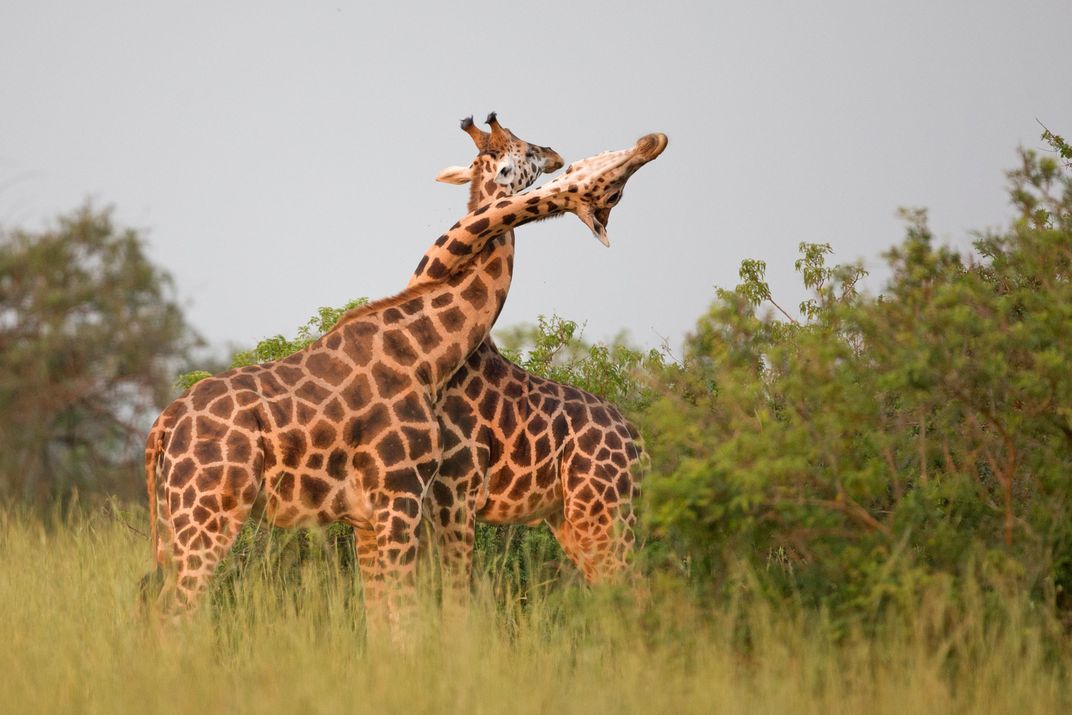
Brown zipped around with the two rangers he was training, taking photographs of the giraffes’ right and left sides. Then he transferred the images onto a laptop and loaded them into Wild-ID, a software program developed at Dartmouth that allows wildlife managers to identify individual animals and monitor them over time. Each giraffe’s spot pattern is as unique as a fingerprint. Once an individual is identified, its identity will come right up any time someone enters a photo of its flank into Wild-ID.
Brown and the rangers went off to find the other six giraffes, and I stayed with the original nine, watching them file behind some bushes. Just one of them hung back and stared at me. He was either more curious than the others, or he’d been given the job of keeping an eye on me. Either way, he seemed wary.
I got out of the truck and lay down in the grass, completely still, as if I were dead. This got all the giraffes’ attention for a moment. The ones who had been hiding emerged from behind the bushes, then circled back. None of them approached me.
The next morning, we found the two groups again in a different part of the park, with a couple of membership swaps between them. The new group of seven had no interest in being photographed and moved at a lope up a slope too thickly wooded for us to follow them. This was the first time since their arrival that they’d been bothered by humans in vehicles, and they were skittish. The rangers keep tabs on them, but from a distance.
“We’re getting to know each other,” said Azariah Kameraho, a ranger who’d been at the park for 14 years. “They’re doing well here because there are many different kinds of acacia for them to eat.” He told me a drought brought the acacias back: They do better in dry conditions than grass does. Now the overgrowth of acacia is making it hard for other animals to feed. “So we’re hoping the giraffes will help us while helping themselves,” Kameraho said.
The next morning, we drove toward Murchison Falls, some 200 miles away, where Brown would check in on the 1,500-plus giraffes his team has identified there. (He believes he and his colleagues have photographed most of the adult giraffes in the park.) One of the central questions he’s exploring is why their numbers are growing. Among other reasons, he thinks it might be because the elephants here were poached so heavily during Uganda’s 20-year civil war. In 1958 there were 12,389 elephants in the park. Now there are about 1,330. Their dwindling numbers enabled more acacias to grow, creating less competition for the trees’ foliage and fruit.
We stopped at Masindi and had lunch at the hotel where Humphrey Bogart, Katharine Hepburn and John Huston stayed while filming The African Queen. Then we continued to the park entrance. The falls—named for Sir Roderick Murchison, the president of the Royal Geographical Society, by the first Europeans to explore the region in 1860—are one of the most impressive displays of water’s force on the planet. The Victoria Nile, after spilling out of Lake Victoria and picking up the discharge of other big rivers on the way, squeezes through a 23-foot-wide slit in the Bunyoro escarpment and comes thrashing down 141 feet. Then the river continues through the lake-studded western arm of the Great Rift Valley for 35 miles until it reaches its delta in Lake Albert, the northernmost point of the lake, entering just above its outlet, known as the Albert Nile. The river splits the park, and you have to take a ferry to get to the north side, where there is an epic savanna full of wildlife.
Making our way through the park, we proceeded into a closed-canopy forest where chimpanzees, monitor lizards and Abyssinian ground hornbills stood in the road. At the south bank of the Victoria Nile, big gobs of foam from the falls floated down the swift current, now half a mile wide. I’d visited the falls 25 years earlier and seen a dozen enormous Nile crocodiles, each 20 feet long, stacked like logs, snoozing on the bank.
There was a place down at the delta that will be forever etched in my brain as an Henri Rousseau-esque tableau vivant of Eden. Bug-eyed hippos jostled and harrumphed in the water, among lily pads patrolled by jacanas, long-legged brown birds looking intently for fish to stab. In a grove of magnificent Acacia sieberiana—flat-topped, bowl-shaped, with tiers of vegetation on wavy branches, like a Chinese painting—sat a lone black-and-white colobus monkey. Down on the muddy bank, between the hippos and the umbrella trees, several giraffes with splayed forelegs had their heads down, imbibing minerals from the red clay soils of the flood plain. The entire scene was filtered through a film of small, clear-winged dragonflies.
**********
The general sense you get watching giraffes is that they are gentle, stately, inquisitive creatures. As long as we stayed in the truck, they didn’t seem to mind our being there. We saw more than 800 in the course of a week, scanning the savanna like conning towers, with their huge, long-lashed eyes. There were lions, hyenas and leopards in the park, but the giraffes far outnumbered their predators. With safety in numbers, they seemed relaxed. Many were confident enough to rest on their folded forelegs, a position that makes it hard for a giraffe to get up quickly.
There was one old dark male, an aging lothario, who was always in the same place. Once, as the sun was sinking, he was all alone. Just below him was an allée of acacias where we watched a mother lion stash her three little cubs while she went off to hunt. But she wasn’t interested in the old fellow. Nobody was. He was just a dilapidated hidalgo with a clipped tail, waiting for the end.
Most of the younger male giraffes seemed preoccupied with procreation. One afternoon, we watched half a dozen young males approach a group of females on one of the trails. The largest male raised his head and bared his upper teeth, inhaling the females’ scent through his vomeronasal organ—an extra olfactory organ many animals have on the roofs of their mouths. Female giraffes come into estrus every two weeks. The male smelled one that was in heat. He confirmed this by licking her vagina and then attempting to mount her, but she kept walking away slowly and finally went into a clump of bushes where he couldn’t bother her. Another, smaller male joined him, also waiting for her to come out. But she wasn’t interested, and they both eventually gave up. So the female giraffe has a degree of choice.
When there is copulation, there is not a lot of obvious engagement. It was nothing like what I saw between young males. Typically, we’d watch a group of maybe ten males making their way through the savanna, eating acacia and other plants. Two of them would hang back and start “necking,” entwining their necks, one rubbing the other’s just below his upraised head. Then the other would sweep down and bash his friend’s thigh or buttocks with his head.
This agonistic tango, as I came to think of it, went on for minutes. Decades ago, Dagg described this kind of male-on-male behavior as homosexual; these days, most giraffe researchers consider that view outdated. To my untrained eye, there appeared to be a strong element of affection. But they were also sparring, possibly seeing which one was stronger, establishing their pecking order and which one had the first crack at the estrus females. Sometimes it becomes a knock-down, drag-out affair. I didn’t see this, but Brown told me he had. A giraffe’s head, swung like a heavy ball on the long chain of its neck, can inflict serious damage, though it rarely causes fatalities.
One day, I came across an injured mother giraffe with a young calf. She had a gaping wound on her back left leg from a snare and could barely walk. Brown relayed her GPS coordinates to the park’s veterinarian and his co-workers, who stay very busy. According to park officials, some of the local Luo people come into the park at night from their villages on the other side of the Albert Nile and set snares to catch antelope, but elephants and giraffes become unintended victims. (The Luo have traditionally avoided giraffe meat out of a belief that it causes leprosy.) The more the animals struggle to get out of the snares, the deeper the cuts.
In 2013, a highly motivated new administration established an anti-poaching ranger unit, with a speedboat and three stations on the river provided by the Uganda Conservation Foundation. Informants in the Luo villages phone the rangers the minute they catch word of a nocturnal bushmeat safari, and the rangers are waiting for them. Brown called the rangers “heroic” but noted that some trap-setters are still able to slip past them.
For the most part, the giraffes of Murchison Falls have a placid existence. I will never forget the sight, which we witnessed dozens of times, of a file of giraffes ambling soundlessly one after the other across a curving rise in the savanna, their bodies silhouetted against the sky, their necks extended far forward, like the accent marks on French words. They walked in synchrony, so lightly and gracefully they seemed almost to be floating.
**********
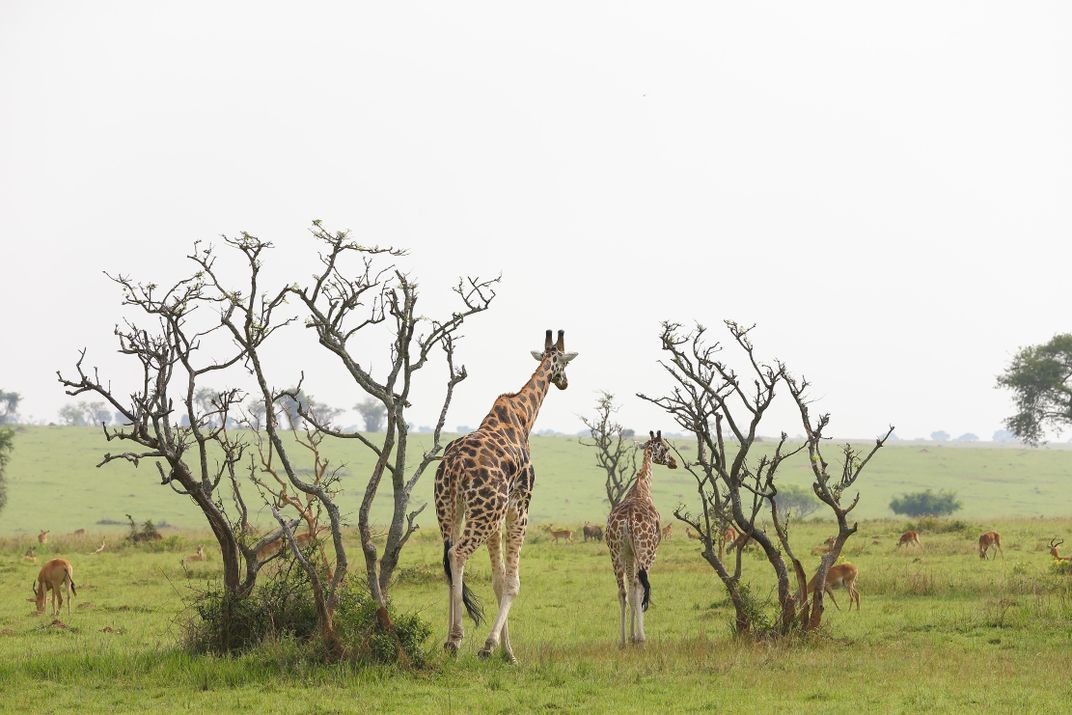
Throughout my stay in Uganda, I tried again and again to connect with the giraffes. Once, I picked up my little traveling guitalele and played a sequence of cascading notes for a group of giraffes. They immediately snapped to and listened with what seemed like great interest. Their little white ears, which had been dancing like butterflies to shoo away flies, stopped fluttering. After several minutes, they moved on, as if to say, “Is this all he’s got?”
Another time, I was alone in the wooded savanna for half an hour. I sat absolutely still, and a semicircle of giraffes, also absolutely still, watched me intently. But none of them would come closer than 200 feet. Then I lay down so they couldn’t see me, but I could see some of them through the blades of tall grass. They stayed frozen, their eyes trained on me. But I didn’t feel the connection I’d felt with the giraffes in Rwanda. The conditions weren’t right. Maybe it was my little nieces who broke the ice. It isn’t something you can force to happen.
Giraffe facial expressions, like so many things about these remarkable beings, have not been properly studied. Once, I watched a giraffe chewing on an antelope bone, which Fennessy says they do to ingest phosphorus and other minerals. His rubbery, prehensile lips made hilarious expressions as he rolled a white bone around his mouth like a cigarette. Not infrequently, giraffes looking at us would lick their lips with their 18-inch tongues—not in any expressive way, just as a byproduct of cud-chewing.
Despite their captivating mannerisms, giraffes have never won over the popular imagination the way other animals have. “It’s funny there’s no Babar of the giraffes,” I said to Fennessy. “It’s like people take them for granted.”
Fennessy told me about Zarafa, a 2012 animated French-Belgian film about a boy who befriends an orphaned giraffe. There’s also Sophie the Giraffe, a French teething toy that has made its way to American stores, and Melman, from the DreamWorks animated film Madagascar. Still, even those giraffe characters don’t have species-specific traits—nothing like Babar’s regal bearing or George’s simian curiosity.
As Fennessy puts it, “Giraffes need a voice.” Many people literally assume that giraffes are mute. “But get between a mother and her young one,” says Fennessy, “and she’ll roar at you like a lion. They huff and puff and scream and yell. We’ve also seen them mourn their dead, walking regularly past the bodies of their family members.” Fennessy would like to see many more researchers gathering data on different giraffe populations the way Brown does. “If we had a suite of Michaels all across the continent, giraffes would be in a much better place.” He’ll get no argument about that from me, although I am only beginning to realize how little I know about them.
Related Reads
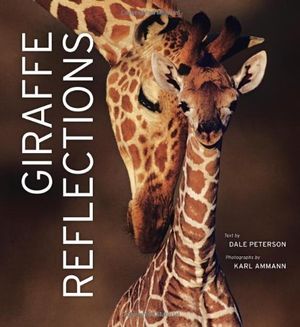
Giraffe Reflections
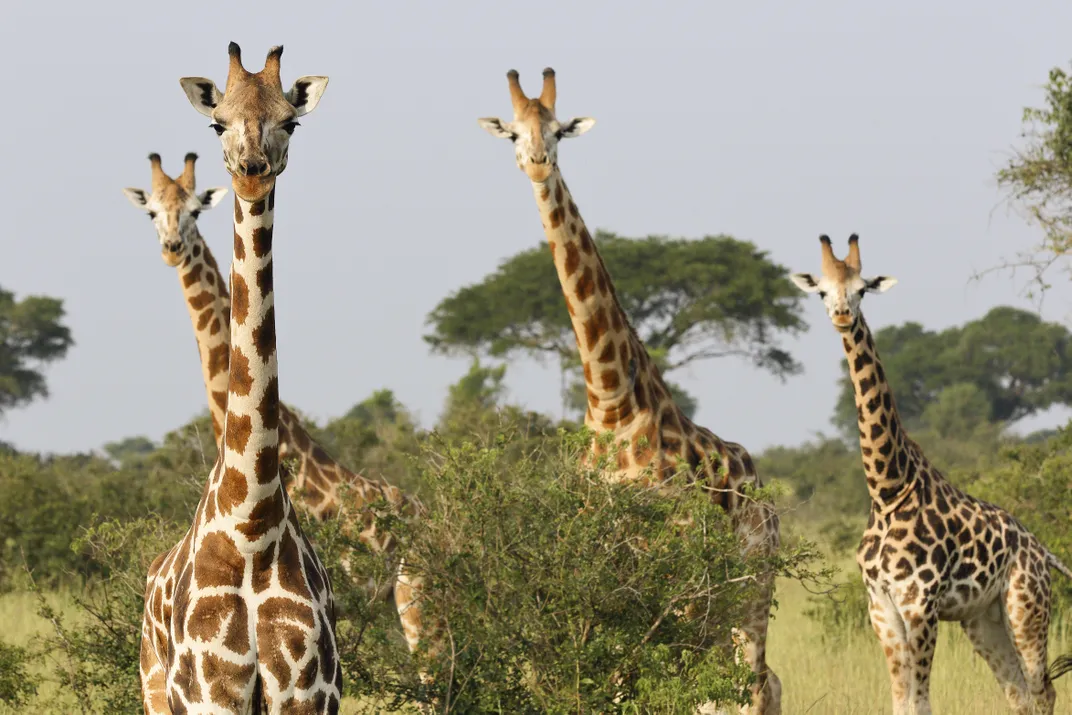
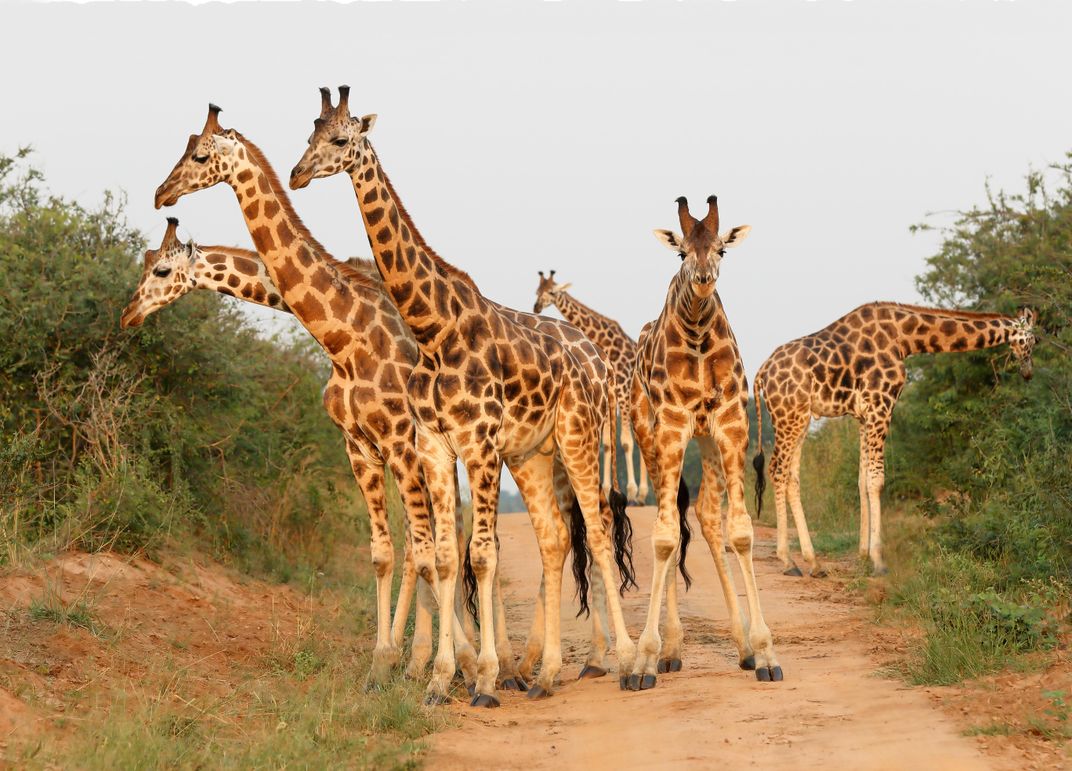
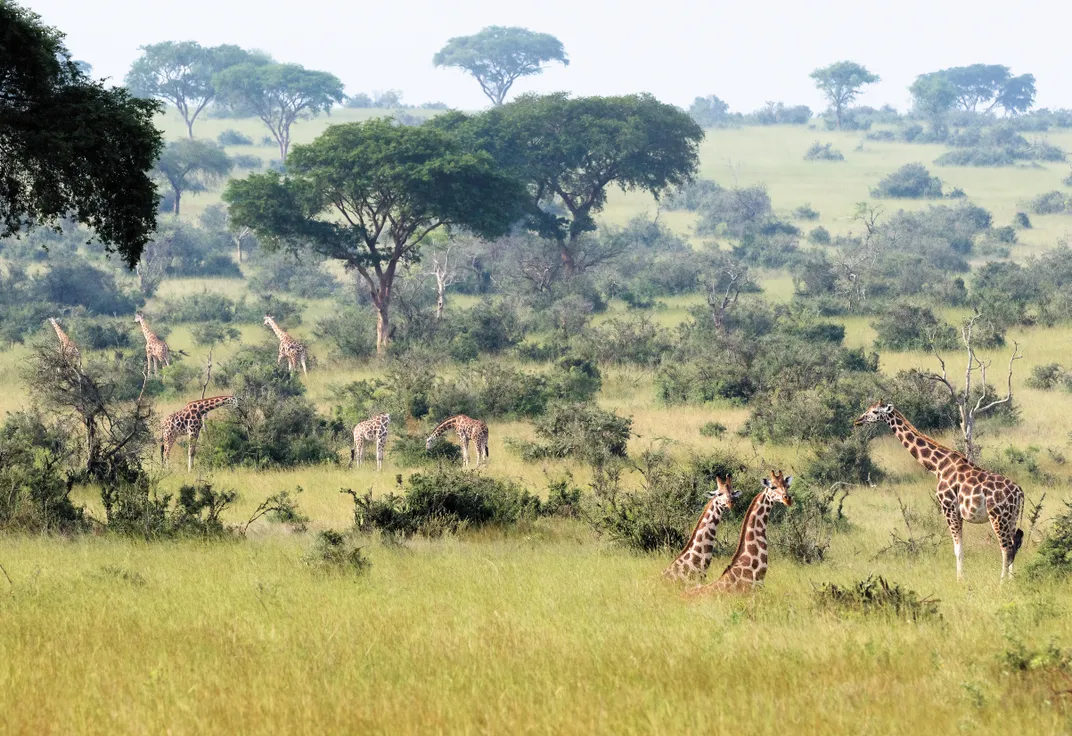
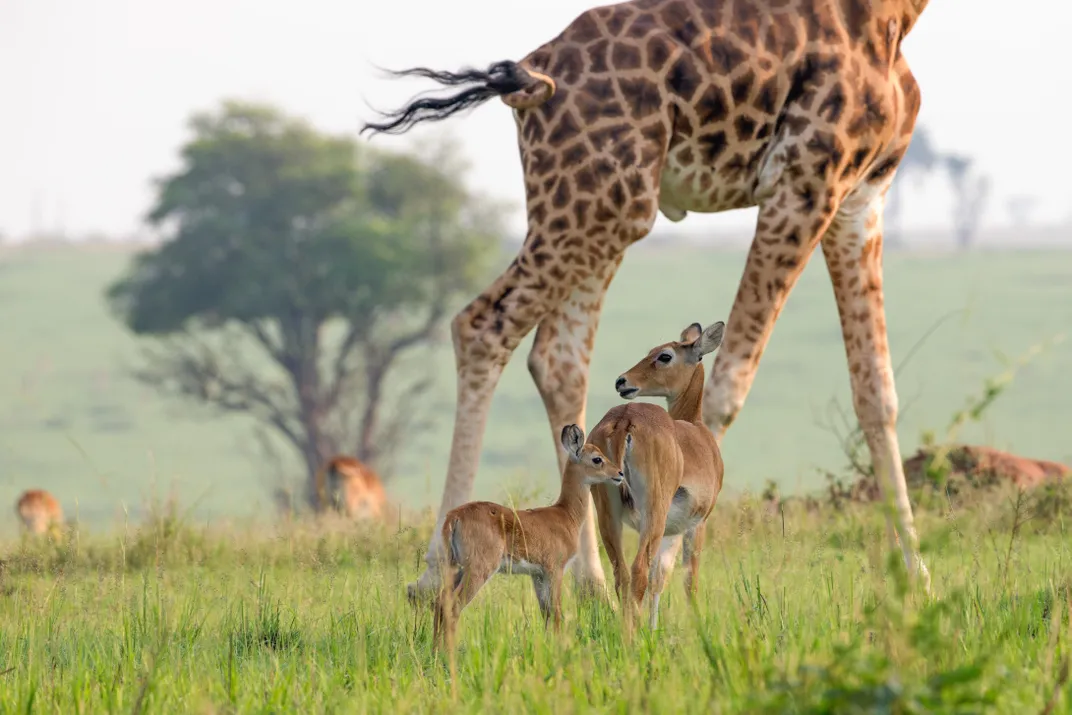
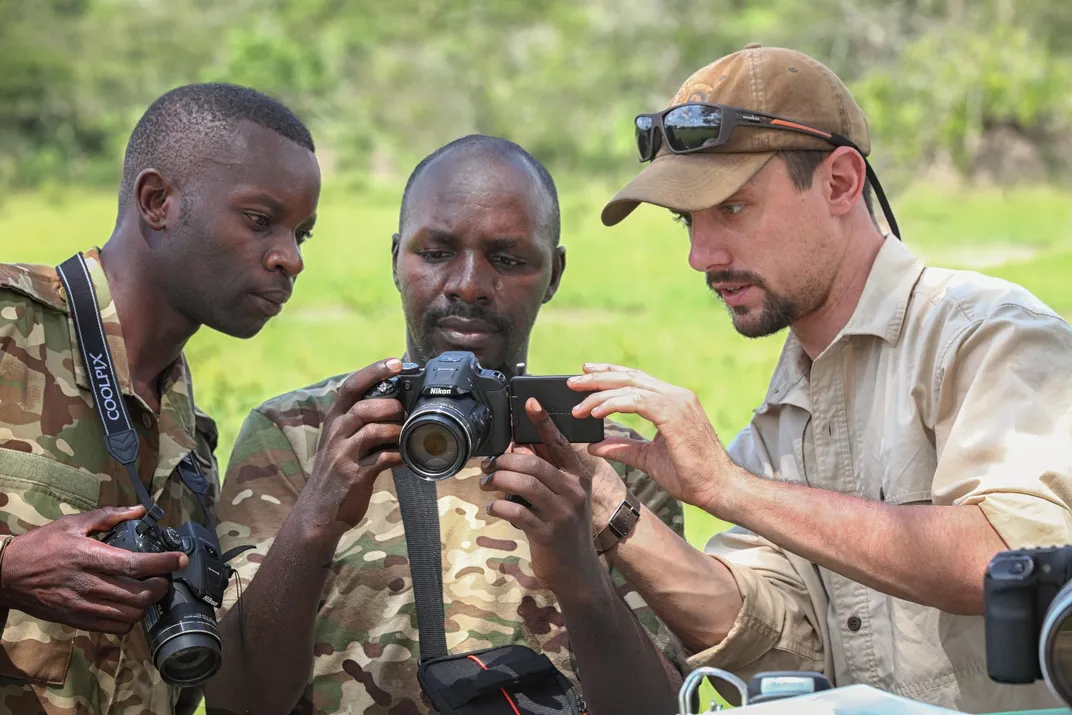
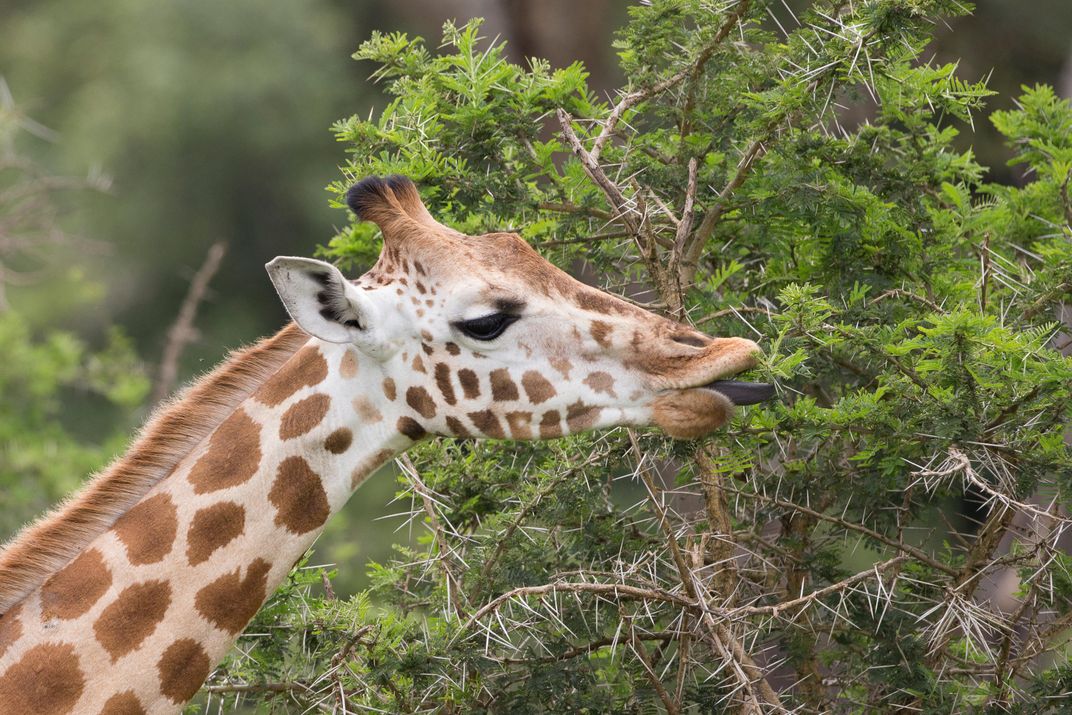
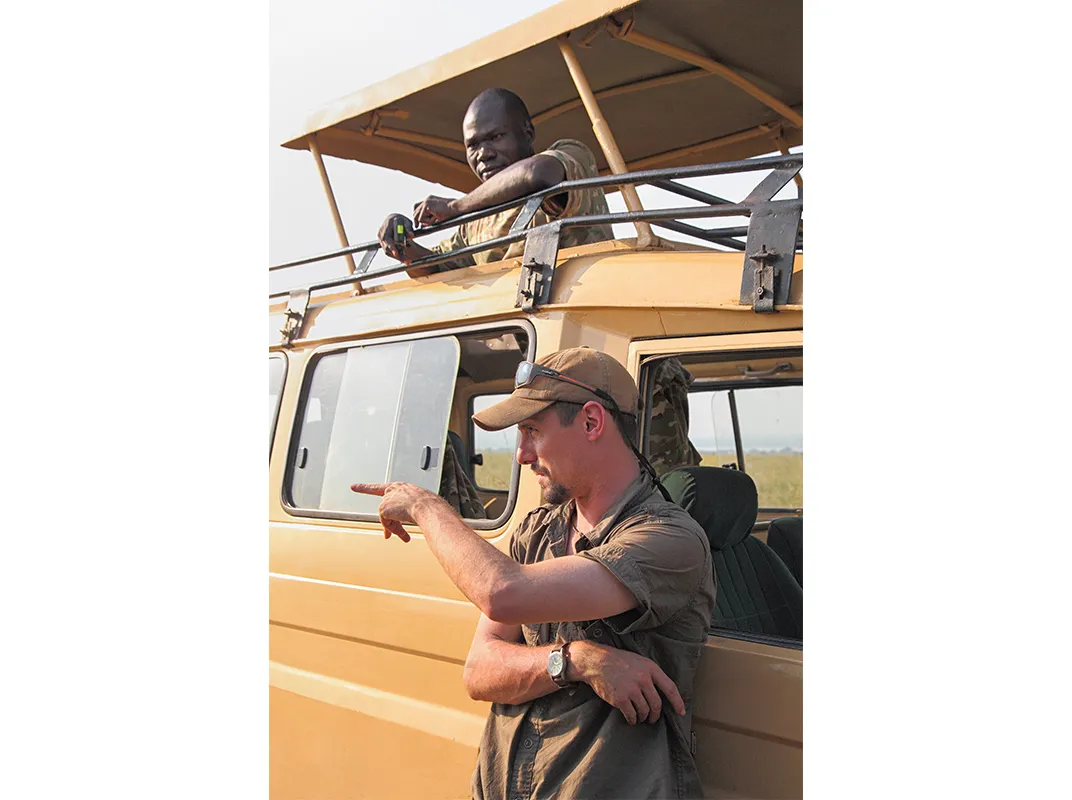
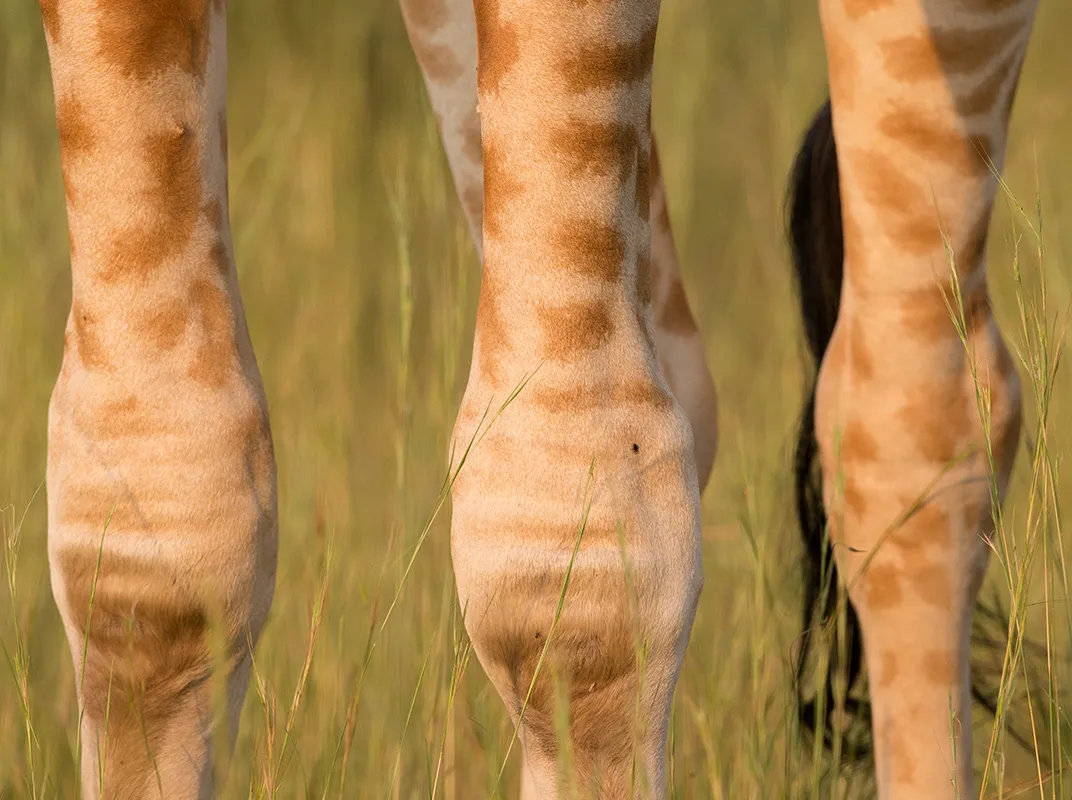
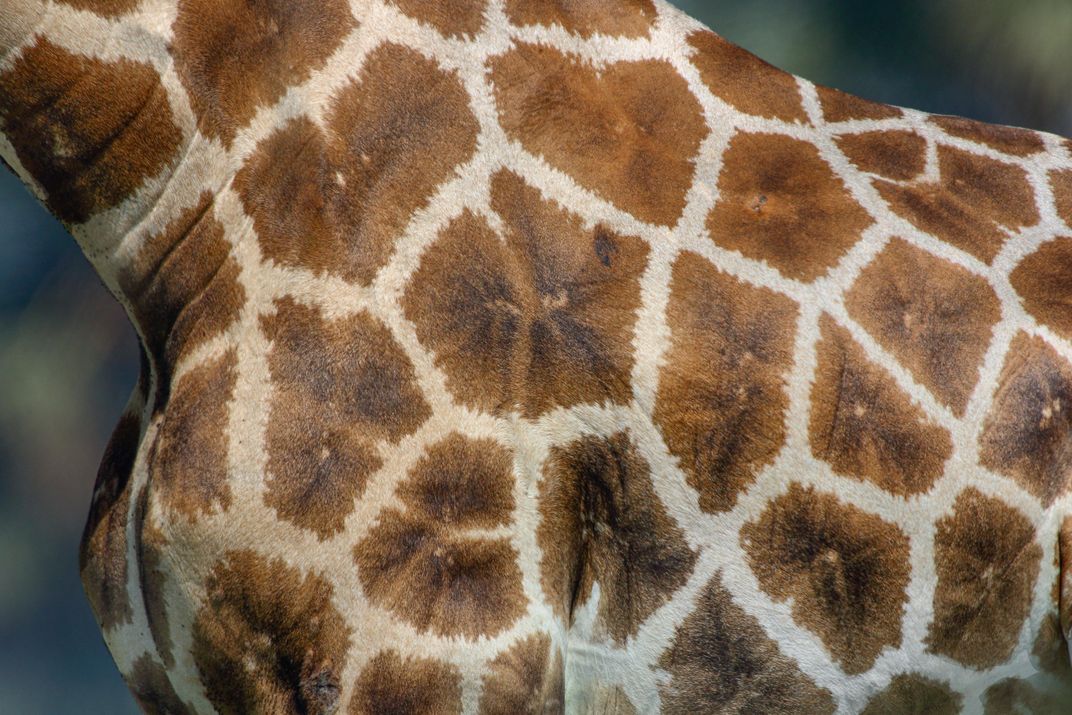
/https://tf-cmsv2-smithsonianmag-media.s3.amazonaws.com/accounts/headshot/Shoumatoff.jpg)